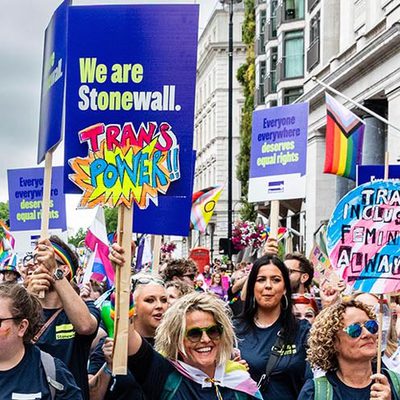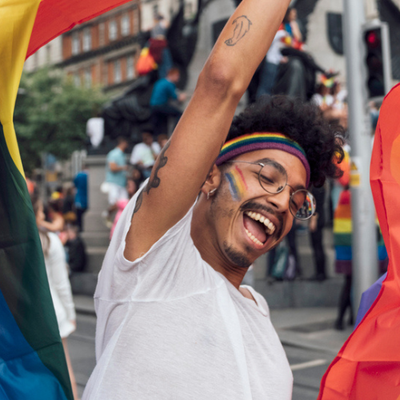
List of LGBTQ+ terms
Not sure what language to use to refer to the LGBTQ+ community, or how to define a key term?
Below are suggested definitions for key terms relating to LGBTQ+ identities and experiences.
There’s no one ‘right’ way of saying things. Identities are deeply personal, and many people will define theirs using language that looks different to ours. Language is also evolving constantly, and LGBTQ+ terms are no exception to this.
When using language relating to the LGBTQ+ community, the most important thing is to be kind and respectful. If you’re ever unsure how a person describes themselves and wants to be described by others, just ask.
- A-D
A
Abro (sexual and romantic)
A word used to describe people who have a fluid sexual and/or romantic orientation which changes over time, or the course of their life. They may use different terms to describe themselves over time.
Ace
An umbrella term used specifically to describe a lack of, varying, or occasional experiences of sexual attraction. This encompasses asexual people as well as those who identify as demisexual and grey-sexual. Ace people who experience romantic attraction or occasional sexual attraction might also use terms such as gay, bi, lesbian, straight and queer in conjunction with asexual to describe the direction of their romantic or sexual attraction.
Ace and aro/ace and aro spectrum
Umbrella terms used to describe the wide group of people who experience a lack of, varying, or occasional experiences of romantic and/or sexual attraction, including a lack of attraction. People who identify under these umbrella terms may describe themselves using one or more of a wide variety of terms, including, but not limited to, asexual, ace, aromantic, aro, demi, grey, and abro. People may also use terms such as gay, bi, lesbian, straight and queer in conjunction with ace and aro to explain the direction of romantic or sexual attraction if and when they experience it.
Allo (sexual and romantic)
Allo people experience sexual and romantic attraction, and do not identify as on the ace or aro spectrum. Allo is to ace and aro spectrum identities, as straight is to LGB+ spectrum identities. It is important to use words that equalise experience, otherwise the opposite to ace and aro becomes ‘normal’ which is stigmatising.
Aro
An umbrella term used specifically to describe a lack of, varying, or occasional experiences of romantic attraction. This encompasses aromantic people as well as those who identify as demiromantic and grey-romantic. Aro people who experience sexual attraction or occasional romantic attraction might also use terms such as gay, bi, lesbian, straight and queer in conjunction with asexual to describe the direction of their attraction.
Aromantic
A person who experiences little to no romantic attraction.
Aromantic people may or may not experience sexual attraction. Those who experience sexual attraction might also use terms such as gay, bi, lesbian, straight and queer in conjunction with aromantic.
Asexual
A person who does not experience sexual attraction. Some asexual people experience romantic attraction, while others do not. Asexual people who experience romantic attraction might also use terms such as gay, bi, lesbian, straight and queer in conjunction with asexual to describe the direction of their romantic attraction.
Ally
A straight and/or cis person who supports members of the LGBTQ+ community. Members of the LGBTQ+ community can also be allies to one another.
B
Bi
Refers to someone who is attracted to more than one gender.
Bi people may describe themselves using one or more of a wide variety of terms, including, but not limited to, bisexual, pan and queer. Stonewall uses ‘bi’ as an umbrella for these terms.
Biphobia
Prejudice or negative attitudes, beliefs or views about bi people. This can include the fear or dislike of someone who is, or is perceived to be, bi.
Butch
A term predominantly used to describe masculine lesbians.
C
Cisgender or Cis
Someone whose gender is the same as the sex they were assigned at birth. For example, a cis(gender) woman is someone who was assigned female at birth and continues to live and identify as a woman.
Coming out
'Coming out' is when a person first tells someone/others about their sexual orientation and/or gender identity.
D
Deadnaming
Calling someone by their birth name after they have changed their name. This term is often associated with trans people who have changed their name as part of their transition.
Demi (sexual and romantic)
An umbrella term used to describe people who may only feel sexually or romantically attracted to people with whom they have formed an emotional bond. People may also use terms such as gay, bi, lesbian, straight and queer in conjunction with demi to explain the direction of romantic or sexual attraction as they experience it.
- E-H
F
Femme
A term predominantly used to describe feminine lesbians. It is also sometimes used more generally to describe feminine LGBTQ+ people.
G
Gay
Refers to a man who is attracted to men. Some non-binary people also identify with this term.
Gay is also a generic term for lesbian and gay sexuality. For example, some women define themselves as gay rather than lesbian.
Gender
A person’s innate sense of being a man, woman, non-binary (see below) or another gender.
Gendered norms, roles and behaviours exist, which are typically associated with being a woman, man, girl or boy. These are often expressed in terms of masculinity and femininity, and vary across cultures.
A person’s gender is typically assumed from the sex they were assigned at birth.
Gender dysphoria
A term used to describe the discomfort or distress that a person experiences when there is a mismatch between their sex assigned at birth and their gender identity.
Gender expression
How a person expresses their gender outwardly. This could be through cues such as clothing, haircuts and behaviour.
Gender identity
A person’s innate sense of their own gender, whether male, female or something else (see non-binary below), which may or may not correspond to the sex assigned at birth.
Gender incongruence
A term used to describe the mismatch between a person’s gender and the sex they were assigned at birth.
This is also the clinical diagnosis used by the NHS for someone who is trans.
Gender non-conforming
A person whose gender expression doesn’t align with societal expectations of gender. Both cis and trans people can be gender non-conforming.
Genderqueer
A term for people whose gender identity doesn’t sit comfortably with ‘man’ or ‘woman’. It is also used by people who reject binary gender roles and/or normative gender expression. Genderqueer is often used in a similar way to non-binary (see below).
Gender reassignment
‘Gender reassignment’ is the phrase used in the Equality Act 2010 to describe the characteristic under which trans people are protected from discrimination in the workplace and wider society.
The phrasing of the Equality Act 2010 says that a person is covered by the protected characteristic of gender reassignment if they are ‘proposing to undergo, is undergoing or has undergone a process (or part of a process) for the purpose of reassigning the person's sex by changing physiological or other attributes of sex’.
‘Gender reassignment’ is generally used when referring to the law. It is commonly referred to as ‘transition’ or ‘transitioning’ (see transitioning below).
Gender Recognition Certificate (GRC)
This enables trans people to be legally recognised in their affirmed gender and to be issued with a new birth certificate, if they choose. You currently have to be over 18 to apply.
Gillick competence
A term used in medical law to decide whether a child (under 16 years of age) is able to consent to their own medical treatment, without the need for parental permission or knowledge.
Grey (sexual and romantic)
Also known as grey-A, this is an umbrella term which describes people who experience attraction occasionally, rarely, or only under certain conditions. People may also use terms such as gay, bi, lesbian, straight and queer in conjunction with grey to explain the direction of romantic or sexual attraction as they experience it.
H
Heterosexual/straight
Refers to a man who is attracted to women or to a woman who is attracted to men.
Homosexual
A term to describe someone who is attracted to someone of the same sex or gender. The term ‘gay’ is now more generally used.
Homophobia
Prejudice or negative attitudes, beliefs or views about gay people. This can include the fear or dislike of someone because they are, or are perceived to be, gay.
- I-L
I
Intersex
A term used to describe a person who has biological attributes of both male and female sexes or whose biological attributes do not fit with societal or medical assumptions about what constitutes male or female.
Intersex people may identify as male, female, non-binary or otherwise.
L
Lesbian
'Lesbian' refers to a woman who is attracted to women. Some non-binary people may also identify with this term.
Lesbophobia
Prejudice or negative attitudes, beliefs or views about lesbians. This can include the fear or dislike of someone because they are or are perceived to be a lesbian.
LGBTQ+
An acronym commonly used to describe people who are lesbian, gay, bi, trans, queer, questioning and ace.
Other commonly used acronyms include LGBT (lesbian, gay, bi and trans), LGBTQ (lesbian, gay, bi, trans and queer), and LGBTI (lesbian, gay, bi, trans and intersex).
- M-P
N
A term for people whose gender doesn’t sit comfortably with ‘man’ or ‘woman’. Non-binary identities are varied and can include people who identify with some aspects of binary identities, while others reject them entirely.
O
Orientation
A term describing a person's attraction to other people. This attraction may be sexual (sexual orientation) and/or romantic (romantic orientation).
Orientations include, but are not limited to, lesbian, gay, bi, ace and straight.
Outed
When an LGBTQ+ person’s sexual orientation or gender identity is disclosed to someone else without their consent.
P
Person with a trans history
Someone who identifies as male or female or a man or woman, but was assigned the opposite sex at birth. This is increasingly used by people to acknowledge a trans past.
Pan
Refers to a person whose attraction towards others doesn’t regard sex or gender. Stonewall includes pan within its umbrella term ‘bi’ (see above).
Passing
When a trans person is perceived to be the gender with which they identify, based on their appearance.
Platonic partnerships
People who are on the ace and/or aro spectrum may have platonic partnerships. These are relationships where there is a high level of mutual commitment which can include shared life decisions, shared living arrangements, and co-parenting of children. These partnerships can include more than two people. Like allosexual and alloromantic people, ace and aro spectrum people may be monogamous or polyamorous.
Pronoun
Pronouns are words we use to refer to people’s gender in conversation - for example, ‘he’, ‘she’ or ‘they’.
- Q-Z
Q
Queer
A term used by those wanting to reject specific labels of sexual orientation and/or gender identity. It can also be a way of rejecting the perceived norms of the LGBTQ+ community (such as racism, sizeism, and ableism).
The term was historically used a slur, and is still viewed as such by some LGBT people. However, others have reclaimed and now embrace the term.
Questioning
The process of exploring your own sexual orientation and/or gender identity.
QTIPOC
An acronym that stands for Queer, Transgender and Intersex People of Colour.
R
Romantic orientation
A person’s romantic attraction to other people, or lack thereof. Along with sexual orientation, this forms a person’s orientation identity.
Stonewall uses the term ‘orientation’ as an umbrella term covering sexual and romantic orientations.S
Sex
The categories of male and female, which are assigned to a person on the basis of their primary sex characteristics (genitalia) and reproductive functions.
‘Sex’ also refers to sexual activity and intercourse.
Sexual orientation
A person’s sexual attraction to other people, or lack thereof. Along with romantic orientation, this forms a person’s orientation identity.
Stonewall uses the term ‘orientation’ as an umbrella term covering sexual and romantic orientations.
Spectrum
A term used to cover a variety of identities that have a root commonality or shared experience.
T
Trans
A term to describe people whose gender is not the same as, or does not sit comfortably with, the sex they were assigned at birth.
Stonewall uses ‘trans’ as an umbrella term including (but not limited to) transgender, transsexual, genderqueer, genderfluid, non-binary, agender, trans man, trans woman, trans masculine and trans feminine.
Transgender man
A term used to describe a man who was assigned female at birth. This may be shortened to trans man, or FTM, an abbreviation for female-to-male.
Transgender woman
A term used to describe a woman who was assigned male at birth. This may be shortened to trans woman, or MTF, an abbreviation for male-to-female.
The steps a trans person takes to live in their gender. Each person’s transition will involve different things. For some this involves medical intervention, such as hormone therapy and surgeries, but not all trans people want or are able to have this.
Transitioning also might involve things such as telling friends and family, using different pronouns, dressing differently and changing official documents.
Transphobia
Prejudice or negative attitudes, beliefs or views about trans people. This can include the fear or dislike of someone based on the fact they are, or are perceived to be trans.
Transsexual
This was more commonly used in the past as a more medical term (similarly to homosexual) to refer to someone whose gender is not the same as, or does not sit comfortably with, the sex they were assigned at birth.
This term is still used by some today, although many people prefer the term trans or transgender.
U
Undetectable
HIV medication (antiretroviral treatment, or ART) works by reducing the amount of the virus in the blood to undetectable levels. This means the levels of HIV are so low that the virus cannot be passed on. This is called having an undetectable viral load or being undetectable.
For more information, visit the Terrence Higgins Trust.



